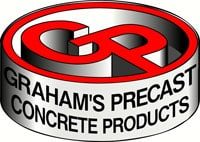Septic tanks are an important component of homes and businesses and can help ensure your wastewater is managed efficiently. However, like any system, these tanks can face issues. In this blog, we’ll look at the role of precast concrete in septic tanks, the signs your tank might need attention and the solutions offered by a precast concrete manufacturer.
The Role of Precast Concrete in Septic Tanks
Precast concrete plays an important role in the construction of septic tanks. Known for its durability and efficiency, precast concrete can ensure septic tanks withstand the elements and serve their purpose for years. The watertight design of concrete septic tanks reduces the likelihood of leaks, making them an eco-friendly choice for wastewater management.
Signs Your Septic Tank Needs Attention
Your septic tank can occasionally show signs indicating that something might be amiss. Recognising these signs early can prevent significant issues down the line and keep your system in good shape. Here are some signs your septic tank might need your attention:
- Odours: Unpleasant smells emanating from the area around your septic tank.
- Pooling Water: Water accumulation around the tank or drain field.
- Slow Drains: Water drains slower than usual in sinks or bathtubs.
- Lush Green Grass: Overly green and spongy grass around the septic tank area, indicating potential leaks.
- Sewage Backup: Raw sewage backing up into your drains or toilets.
Why Concrete Septic Tanks are An Ideal Choice
Among the various options available for septic tanks, concrete stands out for several reasons. Here are some reasons why concrete tanks are often the preferred choice for many residents:
Resilience in Harsh Weather: Concrete tanks are known to withstand the local varying weather conditions, from intense heat to heavy rains.
Longevity: With proper maintenance, concrete septic tanks can last for decades, offering homeowners peace of mind.
Eco-friendly: Concrete tanks, being watertight, reduce the chances of leaks, making them environmentally friendly.
Common Causes of Septic Tank Failures
Septic tanks, while robust and efficient, are not immune to issues. Over time, various factors can contribute to the malfunction or failure of these systems. Understanding these causes is important for you to take preventive measures and help ensure the longevity of your septic tanks. Let’s look at some common reasons that can lead to septic tank problems:
- Poor Maintenance: Not pumping out the tank regularly.
- Tree Roots: Invasion of tree roots can damage the tank structure.
- Chemical Exposure: Dumping harsh chemicals can disrupt the bacterial balance.
- Overloading: Excessive water usage leads to tank overflow.
Precast Concrete Solutions to Septic Tank Issues
When homeowners or businesses encounter septic tank challenges, a precast concrete manufacturer can provide solutions that are durable and efficient:
Tailored Designs
Every property is unique and so are its needs. Precast concrete manufacturers understand this and offer tank designs tailored to individual requirements. Whether it’s a specific size, shape or feature, these manufacturers can craft a tank that fits the bill.
Efficient Installation
Installing a septic tank is not a task for the uninitiated. It requires expertise to help ensure the tank is placed correctly, connected accurately and tested for functionality. Precast concrete manufacturers often provide installation services, so the tank is set up ideally. These teams are trained to handle the intricacies of installation, from site evaluation to testing, so that the system functions seamlessly.
Eco-friendly Solutions
With the increasing emphasis on sustainability, precast concrete septic tanks stand out as an eco-friendly option. Their watertight design reduces the likelihood of leaks, preventing groundwater contamination. Moreover, the robust construction means less frequent replacements, leading to reduced environmental impact.
The Installation Process: Getting it Right the First Time
Installing a septic tank is not just about placing a container in the ground; it’s a careful process that helps ensure the longevity and efficiency of the entire wastewater system. A well-executed installation can save you from frequent issues and costly repairs down the line. Here are some steps involved in this procedure:
- Site Evaluation: Determining the best location for the septic tank.
- Excavation: Digging the site to place the tank.
- Tank Placement: Installing the precast concrete septic tank.
- Connection: Linking the tank to the property’s plumbing system.
- Testing: Ensuring everything functions as intended.
Maintaining the Longevity of Your Septic System
Opting for concrete septic tanks is a decision that pays off in the long run. Not only do they require minimal maintenance, but their robust construction also means fewer replacements. You can rest easy knowing their wastewater system is both efficient and sustainable.
Tailored Septic Solutions for Your Property
At Graham’s Precast Concrete Products Pty Ltd, we understand the challenges faced by Queensland residents when it comes to septic systems. With our expertise and commitment to quality, we offer solutions tailored to your needs. Whether you’re looking for a new septic tank or need advice on maintenance, we’re here to help. Don’t wait for a septic issue to escalate; get in touch via our contact page.






